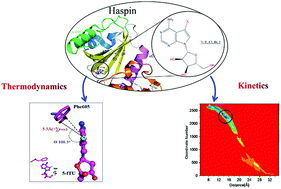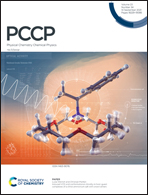Exploring the thermodynamic, kinetic and inhibitory mechanisms of 5-iTU targeting mitotic kinase haspin by integrated molecular dynamics†
Abstract
As a human mitotic kinase, haspin is considered as a promising target for various diseases including cancers. However, no inhibitors targeting haspin have entered clinical trials presently. 5-iTU (5-iodotubercidin) is a useful and classical chemical probe for the investigation of haspin activity, but its inhibitory mechanism remains unclear. In this study, integrated molecular dynamics (MD) of conventional MD, extended adaptive biasing force (eABF), random acceleration MD and well-tempered metadynamics were applied to investigate the thermodynamic and kinetic features of 5-iTU and three derivatives targeting haspin. To emphasize the importance of gatekeeper Phe605, two haspin mutants (F605Y and F605T) were also built. The results showed that the binding affinity of 5-iTU and haspin was highest in all wild type (WT) systems, relying on the strong halogen aromatic π interaction between 5-iTU and gatekeeper Phe605. Gatekeeper mutations, because of damage to this interaction, led to the rearrangement of water distributions at the binding site and the decrease of 5-iTU residence times. Additionally, compared with the smaller 5-fTU, 5-iTU dissociated from WT haspin with more difficulty through distinct unbinding pathways. These findings will provide crucial guidance for the design and development of novel haspin inhibitors and the rational modification of existing inhibitors.

- This article is part of the themed collection: 2021 PCCP HOT Articles


 Please wait while we load your content...
Please wait while we load your content...